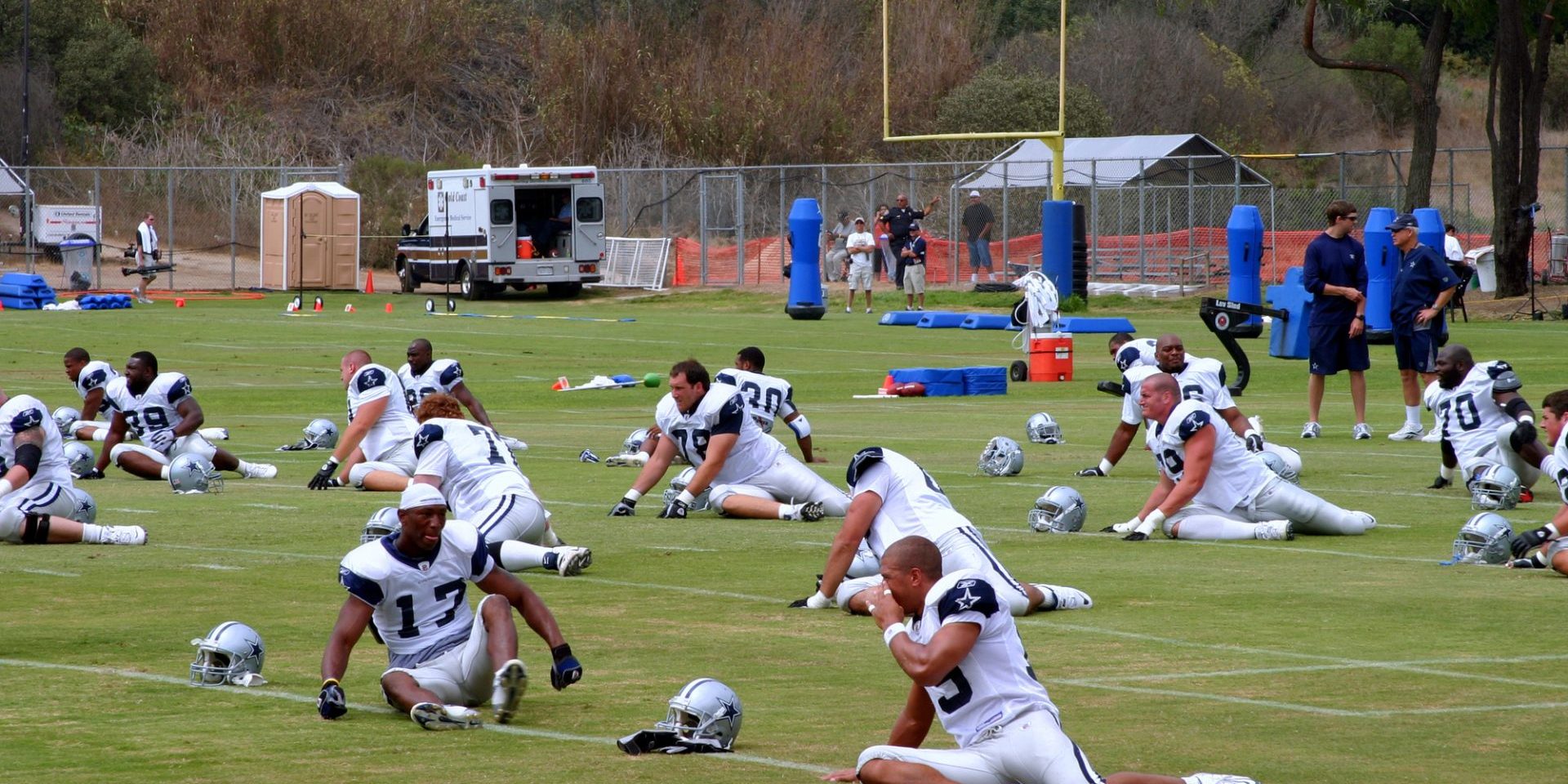The Science of NFL Player Conditioning: How Athletes Stay in Peak Form


Table of Contents
NFL player conditioning is a complex science that combines physical training, nutrition, and recovery strategies. Professional football athletes must maintain peak performance throughout grueling seasons and intense gameplay. Effective conditioning programs for NFL players focus on building strength, speed, agility, and endurance while minimizing injury risk.
Top-level football players cover 10-13 km during a match, with around 1400 activity changes occurring every 4 seconds on average. This intermittent nature of the sport requires players to have excellent cardiovascular fitness and the ability to repeatedly perform high-intensity actions. Strength and power are also critical, as players must accelerate, decelerate, change direction, and engage in physical contact throughout games.
Sleep plays a vital role in NFL player conditioning. Many teams now employ sleep science strategies to improve player recovery and performance. Adequate sleep helps athletes maintain cognitive function, reduce injury risk, and optimize physical recovery between training sessions and games. Some NFL teams have even installed specialized sleep rooms at their training facilities to promote proper rest.
Foundations of NFL Conditioning
NFL conditioning forms the bedrock of player performance, blending scientific principles with practical training methods. It addresses the specific physiological needs of football athletes while leveraging the expertise of dedicated professionals.
Understanding the Physiological Demands
NFL players face intense physical challenges during games and practices. Their bodies must adapt to quick bursts of high-intensity activity followed by brief rest periods. This requires a mix of aerobic and anaerobic fitness.
Football conditioning focuses on developing speed, power, and endurance. Players need the ability to sprint, change direction rapidly, and maintain performance over four quarters.
Energy systems play a crucial role. The phosphagen system fuels short, explosive plays. The glycolytic system supports longer plays and drives. Aerobic metabolism aids recovery between plays and maintains performance late in games.
Position-specific demands shape conditioning programs. Quarterbacks need shoulder stability and rotational power. Linemen require strength and short-burst endurance. Wide receivers and defensive backs prioritize speed and agility.
The Role of Strength and Conditioning Coaches
Strength and conditioning coaches are vital to NFL teams. They design and implement training programs tailored to each player’s needs and position.
These professionals use scientific principles to enhance athletic performance. They focus on:
- Strength training to build muscle and power
- Speed and agility drills to improve on-field movement
- Cardiovascular conditioning for endurance
- Flexibility and mobility work to prevent injuries
Boyd Epley, the first full-time strength coach in college football, pioneered many techniques still used today. Modern coaches continually refine their methods based on new research and technology.
They also work closely with other staff members. This includes collaborating with nutritionists, athletic trainers, and position coaches to create comprehensive player development plans.
Training Regimens for Elite Performance
NFL players undergo rigorous training to maximize their physical capabilities. These programs focus on developing strength, enhancing speed and agility, and optimizing both aerobic and anaerobic fitness.
Developing Strength and Power
NFL athletes incorporate compound exercises to build functional strength and explosive power. Power cleans and front squats are staples in their routines. These movements target multiple muscle groups and mimic on-field actions.
Players typically perform 3-5 sets of 3-6 repetitions for power exercises. This rep range helps develop fast-twitch muscle fibers crucial for explosive movements. Rest periods between sets are kept short, usually 60-90 seconds, to improve work capacity.
Periodization is key in NFL strength programs. Off-season focuses on building raw strength, while in-season maintenance aims to prevent fatigue and injury.
Speed and Agility: Acceleration and Adaptation
Speed development is critical for NFL success. Players engage in sprint training sessions 2-3 times per week. These include short sprints (10-40 yards) and flying sprints to improve acceleration and top-end speed.
Agility drills form another cornerstone of NFL training. Cone drills, ladder exercises, and change-of-direction drills enhance players’ ability to react quickly on the field. These sessions often occur 2-3 times weekly, lasting 30-45 minutes.
Plyometric exercises like box jumps and hurdle hops are integrated to boost explosive power. Players might perform 3-4 sets of 5-8 repetitions, focusing on quality over quantity.
Integrating Aerobic and Anaerobic Exercise Prescription
NFL conditioning blends aerobic and anaerobic training to meet the sport’s varied energy demands. High-Intensity Interval Training (HIIT) is a popular method, involving short bursts of intense activity followed by brief rest periods.
A typical HIIT session might include 30 seconds of all-out effort followed by 30 seconds of rest, repeated for 15-20 minutes. This improves both aerobic capacity and anaerobic threshold.
Concurrent training, combining strength and endurance work, is carefully programmed to avoid interference effects. Strength sessions often precede endurance work, with adequate recovery time between different training modalities.
Players also engage in sport-specific conditioning drills that mimic game situations, enhancing their ability to perform repeated high-intensity efforts throughout a match.
Optimizing Player Health and Recovery
NFL players face immense physical demands, requiring dedicated strategies to maintain peak performance. Effective injury prevention and recovery techniques are crucial for sustained success on the field.
Injury Prevention Strategies
NFL teams employ comprehensive approaches to minimize player injuries. Strength training forms the foundation, focusing on building muscle stability and power. Players engage in targeted exercises to reinforce vulnerable areas like knees, shoulders, and backs.
Flexibility work is equally vital. Regular stretching sessions and yoga improve range of motion, reducing strain on joints and muscles. Many teams incorporate dynamic warm-up routines before practices and games to prepare bodies for intense activity.
Proper technique coaching is essential. Players learn correct form for tackling, blocking, and other high-impact movements to lessen injury risks. Some teams use motion capture technology to analyze and refine player mechanics.
Nutrition plays a key role in injury prevention. Players follow carefully planned diets rich in anti-inflammatory foods and supplements to support joint health and tissue repair.
Recovery Techniques and the Importance of Rest
Rest is fundamental for NFL player recovery. Teams structure training schedules to allow adequate downtime between intense workouts and games. Quality sleep is emphasized, with many players using sleep tracking devices to optimize their rest.
Active recovery methods are widely used. Low-intensity exercises like swimming or cycling help flush out lactic acid and reduce muscle soreness without adding stress to the body.
Massage therapy and foam rolling sessions are common practices. These techniques help break up scar tissue, improve circulation, and speed up muscle recovery.
Cold therapy remains popular for reducing inflammation. Players use ice baths or cryotherapy chambers after games and tough practices. Some teams alternate cold and heat treatments to enhance blood flow and healing.
Monitoring tools track player fatigue and recovery status. Wearable devices measure metrics like heart rate variability and sleep quality, allowing trainers to adjust workloads as needed.
Monitoring and Evolving Training Approaches
NFL teams use advanced methods to track player fitness and adjust training programs. These strategies help athletes maintain peak performance throughout the demanding season.
Assessing Body Composition and Fitness Levels
Teams employ various techniques to measure players’ physical attributes. Physiological measures like heart rate are frequently used to assess fitness. Body composition analysis helps determine muscle mass and body fat percentages.
Performance tests evaluate speed, strength, and agility. These may include sprint tests and agility drills. GPS technology tracks players’ movements during practice and games.
Regular assessments allow coaches to identify areas for improvement. They can then create targeted training plans for each athlete. This individualized approach maximizes training effectiveness.
The Impact of Systematic Reviews on Training Interventions
Systematic reviews of training methods have significantly influenced NFL conditioning practices. These reviews analyze multiple studies to identify the most effective training interventions.
Evidence-based approaches now guide workout design. For example, research has shown the benefits of high-intensity interval training for improving cardiovascular fitness.
Strength training programs have evolved based on scientific findings. Periodization techniques help players build strength while reducing injury risk.
Recovery strategies have also improved through systematic review. Teams now implement science-backed methods like compression garments and proper nutrition to enhance recovery.
Image courtesy Deposit Photos.





